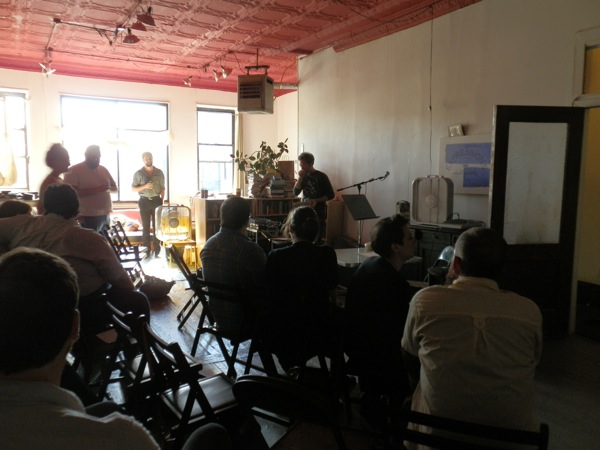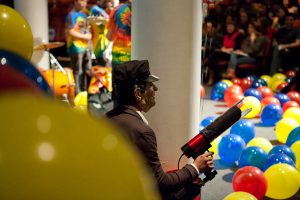Robert Smithson once wrote that “A work of art, when placed in a gallery, loses its charge and becomes a portable object, or surface, disengaged from the outside world.”
Smithson’s controversial words fail to resonate with many art historians and gallery owners. But the artist may have been on to something when he noted that a work of art often “loses its charge” once it’s placed inside a gallery.
After all, art galleries—especially contemporary art galleries—are often designed to separate a work of art “from the outside world.” Gallery spaces are frequently cavernous, and nearly empty. They are painted in shades of white and gray at odds with the riotous colors of the artwork they display. And they rarely reflect the energy and the chaos of the artistic process.
But not every contemporary art gallery seeks to espouse such an antiseptic aesthetic. Many gallery owners frequently paint and repaint the walls of their exhibition spaces, attempting to complement the colors of their paintings and sculptures. Many gallery owners also bring food, drinks, and live music to their openings, hoping to engage and entertain their visitors.
And some gallery owners abandon the idea of a rarefied gallery space altogether, choosing instead to display artwork amidst the chaos and clutter of their own homes. These gallery owners open up apartment galleries, and they revel in the idiosyncrasies and imperfections of the domestic space.
An apartment gallery is just what you might imagine it to be—an exhibition space located in a gallery owner’s apartment. The gallery owner lives, literally lives, with the artwork he or she chooses to display. And visitors who step inside these galleries are not only visiting a commercial exhibition space—they are also visiting someone’s home.
Last week, The Chicago Arts Archive spoke with Caroline Picard, the owner of Green Lantern Gallery, a one-time apartment gallery.
Caroline was kind enough to share her experiences as the owner of an apartment gallery with us here:
Why did you choose to open Green Lantern as an apartment gallery—rather than a storefront gallery?
I actually just sort of stumbled into the space. I had been house sitting for a year and had just decided that I was going to stay in Chicago, so I thought I could look for a more permanent living situation. At first I was looking for studio apartments, but then—as I factored in the cost of that place and a separate studio to work in—I got a little overwhelmed by the cost. I happened to be walking down Milwaukee Avenue and saw a “for rent” sign in what would become the gallery. I decided to go and take a look at it. Actually the cost was comparable to what I would have paid for the apartment and the studio. I had always wanted to run an apartment gallery/press and, looking at this empty space, I suddenly felt like I had that chance.
What unique challenges did owning and operating an apartment gallery present?
I realized that my space was ineligible for a business license, so I bumped up against some interesting aspects of civil bureaucracy. On the one hand, people I talked to in the city wanted me to stay open and tried to be really helpful. On the other hand, they couldn’t help and we all agreed, in this case, the rules were stupid. That was pretty interesting.
What did you find most rewarding about owning an apartment gallery?
All of it, probably. It was a great way to be part of and learn from the Chicago contemporary art world. I met some really amazing friends and inspiring artists that way. Sometimes I felt like the gallery was a part of my studio practice, for my own work, because every show always made me think about something differently in my own myopic creative process. I also feel like I learned a lot of administrative skills, how to put out (albeit small) fires, how to organize and plan for events. Those are examples of hands-on, to use your word, “rewards,” but I was also really interested in thinking about what it meant to integrate a public and domestic space. What happened within that intersection, what it meant to exhibit art within that context, and how it seemed to impact the way people participated in the space.
How did visitors respond to your gallery? Did they respond to Green Lantern differently after it became a storefront gallery?
Probably. As you know, the storefront gallery closed this last January, but yes. I think people did respond differently. The storefront space boasted a different aura. It was new and sleek and looked more professional. When the gallery was in my apartment, it always looked like an apartment. Of course the exhibition area was separate from the living quarters, but people still had to cross through the kitchen to use the bathroom; the ceiling was painted red tin (way before I took up residence) and I never changed it. There was also a Bitters sign (an old advertisement) painted on one of the walls in the apartment gallery exhibition space. The storefront space was very clean and so I think it had a different presence than the apartment gallery. People pick up on that.
Did you find owning a storefront gallery more or less rewarding than owning an apartment gallery?
Hard to say. I ended up closing the storefront because it was too expensive. I think the apartment gallery was awesome because it never cost too much more than my own lifestyle. Because of that, I was also able to have the apartment gallery in a much busier neighborhood, which was also nice for day to day traffic. That said, I think it was really important to take steps to see what it would be like to have a storefront. Definitely it’s nice to have a psychological break between where you live and where you work and the stakes were suddenly much higher, which I also think is an important experience to have. I still live in the same original GL gallery, and we still have some public events here—readings and book releases—I sort of feel like I’ll probably always want to do something like that.
What advice would you give to other art enthusiasts interested in opening up an apartment gallery?
Go for it! It’s great. Haha.
That’s probably not what you’re looking for, but I mean it. I think it’s a really important way to take ownership over the possible paths of cultural dissemination that are available in the world. The thing about them too is that they can be anything. You make up the rules. So it’s worth trying it out to see what kind of rules you’d want to make, how you think work should be presented and why. Even thinking through how you want people to feel in that environment—that’s a really useful thing to consider, no matter what you go on to do.
For more information about apartment galleries, read the article Caroline wrote about Green Lantern for the Bad At Sports website here.





